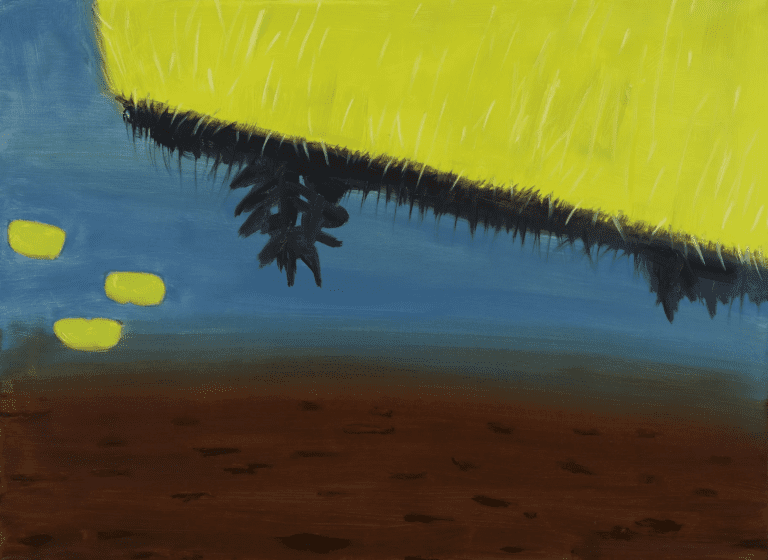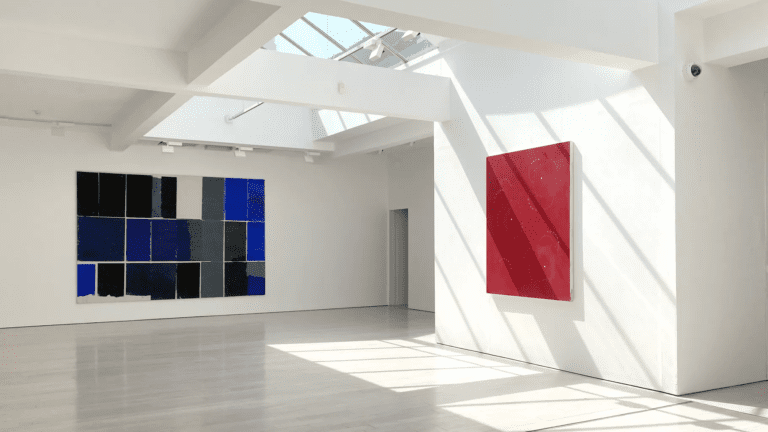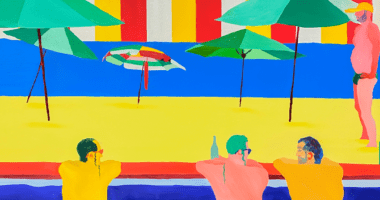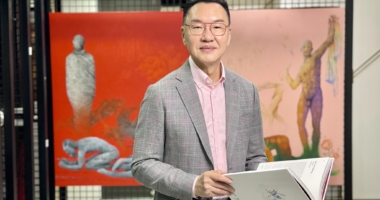
Sean Scully’s Indoor Sleeper (2020) installed in front of Thaddeus Ropac, Salzburg. Photo by Ulrich Ghezzi. Courtesy Thaddaeus Ropac gallery, London • Paris • Salzburg • Seoul.
Where are Thaddaeus Ropac’s collectors during August? “They’re in the Hamptons, or the South of France, or on their boat,” according to the Austrian gallerist. “In my experience, it’s difficult to reach them in the summer.” That’s why his spaces in Paris have always remained closed seasonally—“like all the other galleries,” he said.
Ana Bordenave, communications manager at Galerie Jocelyn Wolff, agreed with this assessment: “The majority of the Parisian galleries are closed,” she said, while noting the benefits of this strategy. “Having a summer break allows us to do substantive activities such as research, inventory, or maintenance work,” she said.

Alex Katz, Reflection with Lilies 2, 2010. Courtesy of Thaddaeus Ropac.
It’s not only the French capital: Many galleries continue the tradition of shutting down for August (and sometimes July), taking the time off from presenting new shows, while their clients take a break from working and, in theory, buying art. But in an increasingly online world, where new buyers may be less wedded to the office, and therefore the idea of the summer break, does this strategy still make sense?
Summer closures are certainly unevenly distributed across the globe. In Beijing, where residents are recovering from the latest COVID-19 lockdowns, visitors are slowly returning (albeit battling travel restrictions). Galleries in Germany, Austria, and Italy seem to follow their French peers in closing for several weeks, while New York and London galleries seem to be split.

Installation view of “Summer Show” at Annely Juda Fine Art, 2022. Courtesy of Annely Juda Fine Art.
“We have had the discussion of whether to close the gallery for part of the summer on and off for years,” said Nina Fellmann, director at London’s Annely Juda Fine Art, which has always stayed open in the summer. Instead, Annely Juda is hosting a summer group show, like many galleries (including Esther Schipper in Berlin, which is featuring Sojourner Truth Parsons and Julia Scher, among others, or Dickinson New York, which has a group show including Martin Kippenberger and Lygia Clark).
These group exhibitions provide a platform for artists outside regular programming. “During the year the schedule is packed with one-person exhibitions or specifically curated group shows, so the summer show is a good opportunity to give a selected overview of the gallery’s artists,” said Fellmann. This style of presentation gives galleries something to show collectors who may be passing through, without the sales pressure that comes with the busier months, she said. It can also be a platform to test out new artists that the gallery may go on to represent.

Kitti Narod The Pool, 2020. Courtesy of Tang Contemporary Art.
As art fairs continue to encroach on previously empty parts of the art calendar, a full closure is more difficult to swing than ever. “With art fairs now going pretty much all year round, it is even more important to keep the gallery open and have people here dealing with everything,” said Fellmann. “Our last art fair finished on July 6th and our next art fair (in Seoul) opens on September 1st, so the summer is busy.”
This is also true for galleries in Asian art market hubs, such as Tang Contemporary Art, which has outposts in Hong Kong, Bangkok, Beijing, and Seoul. “We recently finished Masterpiece London and Art Monte-Carlo,” explained Charlotte Lin, the gallery’s sales and marketing manager. Though the gallery would not be closing over the summer, it will take a long break during Chinese New Year instead, she said.

Gerald Williams, Sun Ship Mode, 1978. Courtesy of Kavi Gupta. Gerald Williams, Astral Traveling #2, 1978. Courstesy of Kavi Gupta.
For some dealers, this squeeze on the summer months has only been exacerbated by the impact of COVID-19. Until recently, Chicago’s Kavi Gupta has always taken summer breaks, but the amount of time the team could squeeze away became shorter and shorter until it was no longer possible. “I really want my staff and team to take a break—they need it,” said founder Kavi Gupta. And yet, since the pandemic began, he explained, the gallery has become busier and busier, with many clients expecting a greater level of engagement from his staff.
Before the pandemic, clients would actually take time off from collecting when they were on vacation. Now, fully immersed in the remote work lifestyle, they are collecting no matter where in the world they are, and expect galleries to keep up. “What’s happening now is the collectors are in their summer homes, but they’re calling, Instagramming, and emailing because they got so used to being able to do that,” Gupta said.

Exterior view of Kavi Gupta, New Buffalo. Courtesy of Kavi Gupta.
Indeed, during the pandemic, Gupta and his wife, Jessica Moss (who is also a principal at the gallery), moved—like many of the arts professionals in Chicago—to their holiday home in New Buffalo, Michigan. There, he’s experienced a real contrast in collectors’ moods. “They’re so relaxed, wearing gardening clothes,” he explained. “You pop by and have a glass of wine and chill.” When the gallery posted online that it was opening a space in New Buffalo—a lakeside summer destination that Gupta compared to the Hamptons—the response was enthusiastic. “Everyone started just emailing and texting the minute we announced it,” he said.
To Gupta, this dynamic shows that collectors are keen to engage with the art world and collect not just online, but also in holiday home destinations. The growth of galleries setting up shop in the Hamptons and other collector holiday spots—like Hauser & Wirth’s breathtaking gallery in Menorca, Spain—is also testament to this trend.

Exterior view of Hauser & Wirth Menorca on Illa del Rei. Photo by Be Creative, Menorca. Courtesy of Hauser & Wirth.
Indeed, for Ropac, this dynamic is nothing new: While most of his galleries take a few weeks off in summer, that’s when his outposts in Salzburg, Austria, have always enjoyed their busiest season, as the world-renowned summer opera festival attracts a “collecting crowd,” he explained. Unless the typical art capitals (which, he said, includes Seoul, where summer holidays are also a norm) become more temperate during August, he said, he doesn’t expect anything to change. “In these metropolitan cities, it’s very hot, very aggressive—I don’t see it,” he said.
This article was written by Josie Thaddeus-Johns.



